 W
WPsyllidae, the jumping plant lice or psyllids, are a family of small plant-feeding insects that tend to be very host-specific, i.e. each plant-louse species only feeds on one plant species (monophagous) or feeds on a few closely related plants (oligophagous). Together with aphids, phylloxerans, scale insects and whiteflies, they form the group called Sternorrhyncha, which is considered to be the most "primitive" group within the true bugs (Hemiptera). They have traditionally been considered a single family, Psyllidae, but recent classifications divide the group into a total of seven families; the present restricted definition still includes more than 70 genera in the Psyllidae. Psyllid fossils have been found from the Early Permian before the flowering plants evolved. The explosive diversification of the flowering plants in the Cretaceous was paralleled by a massive diversification of associated insects, and many of the morphological and metabolic characters that the flowering plants exhibit may have evolved as defenses against herbivorous insects.
 W
WAcizzia is a genus of psyllids that primarily feed on Acacia and Albizia species. Many species are known from Australia and have become widespread as their host plants are popular garden specimens. Damage to the leaves is generally mild. Economic damage on plantation species is occasionally reported.
 W
WAcizzia acaciaebaileyanae is a psyllid common on Acacia baileyana, a popular garden specimen. The psyllid and its host plant are native to Australia, but both are now widespread where the plant has been introduced. The psyllid can reproduce to very high numbers, but appears not to damage the plant.
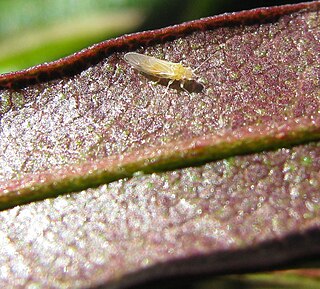 W
WAcizzia dodonaeae is a psyllid common on Dodonaea viscosa.
 W
WAcizzia solanicola is a psyllid from Australia, found on plants of the genus Solanum. It has subsequently been found also in New Zealand.
 W
WAcizzia uncatoides is a species of psyllid native to Australia where it feeds primarily on Acacia and some Albizia species. It is present in many parts of the world where it infests these plant species, presumably introduced with the plants. It is not generally regarded as a pest species although it can proliferate to high numbers. Generalist psyllid predators also feed on this species.
 W
WCacopsylla is a genus of bugs in the Psyllidae family, the jumping plant lice. The genus includes most of the psylla harmful to fruit trees.
 W
WCacopsylla mali is a species of insect belonging to the family Psyllidae.
 W
WCacopsylla melanoneura is an insect of the Psyllidae family. It mainly feeds on Hawthorn. The insect will also feed on apple trees and is considered the main vector of the phytoplasma disease "Ca. Phytoplasma mali" in northwestern Italy.
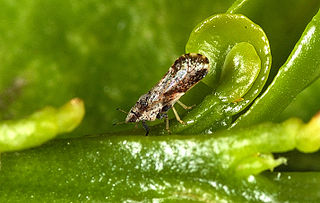 W
WDiaphorina is an Old World genus of sap-sucking hemipteran bugs in the family, Liviidae. It includes an important pest of citrus: the Asian citrus psyllid, D. citri.
 W
WDiaphorina citri, the Asian citrus psyllid, is a sap-sucking, hemipteran bug in the family Liviidae. It is one of two confirmed vectors of citrus greening disease. It has a wide distribution in southern Asia and has spread to other citrus growing regions.
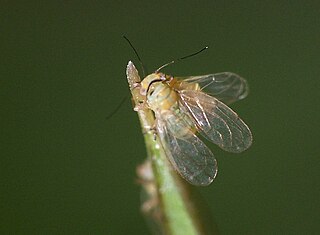 W
WHeteropsylla is a genus of plant-parasitic hemipterans in the family Psyllidae. There are more than 40 described species in Heteropsylla.
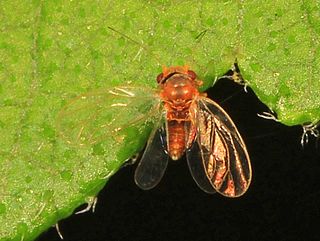 W
WHeteropsylla huasachae is a species of plant-parasitic hemipteran in the family Psyllidae.
 W
WIn biology, a lerp is a structure of crystallized honeydew produced by larvae of psyllid bugs as a protective cover. These animals are commonly referred to as lerp insects.
 W
WPsylla is a genus of sap-sucking insects belonging to the order Hemiptera. There are at least 110 described species in Psylla. Species within the genus feed on various host plants.
 W
WPsylla alni is a species of psyllid, a plant-feeding hemipteran in the family Psyllidae.
 W
WPsylla buxi, known generally as the boxwood psyllid or box sucker, is a species of plant-parasitic hemipteran in the family Psyllidae.
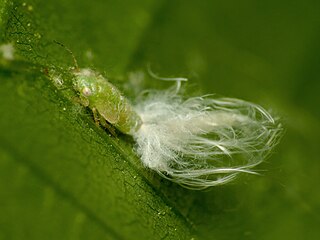 W
WPsylla carpinicola is a species of plant-parasitic hemipteran in the family Psyllidae.
 W
WPsylla pyri, commonly known as the pear psylla or pear psyllid, is a true bug in the family Psyllidae. Originating in Europe and Asia, it has spread to North America. It is a pest of pear trees, sucking the sap, damaging the foliage, flowers and fruit and diminishing the crop.
 W
WPsyllinae is a subfamily of plant-parasitic hemipterans in the family Psyllidae. There are about 12 genera and at least 40 described species in Psyllinae.
 W
WPsyllopsis fraxini is a psyllid which lives within a gall on ash.